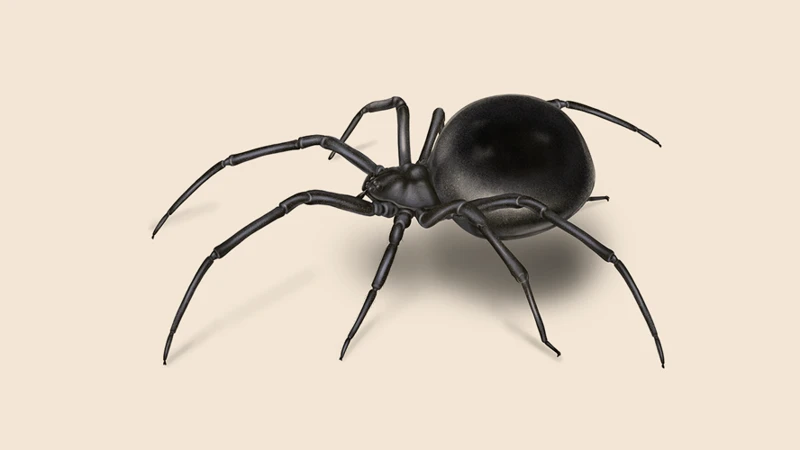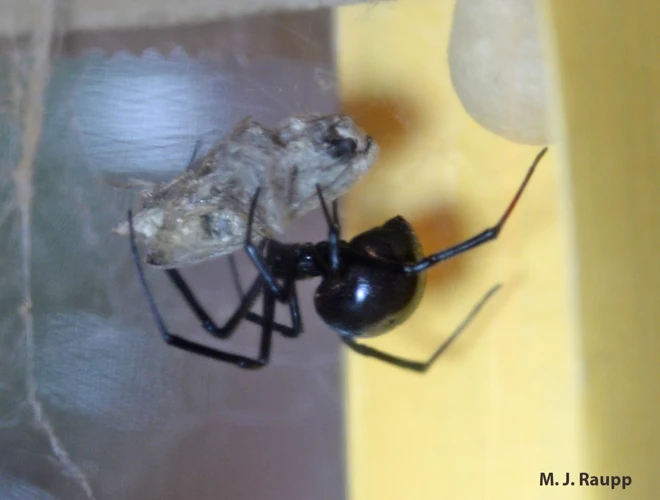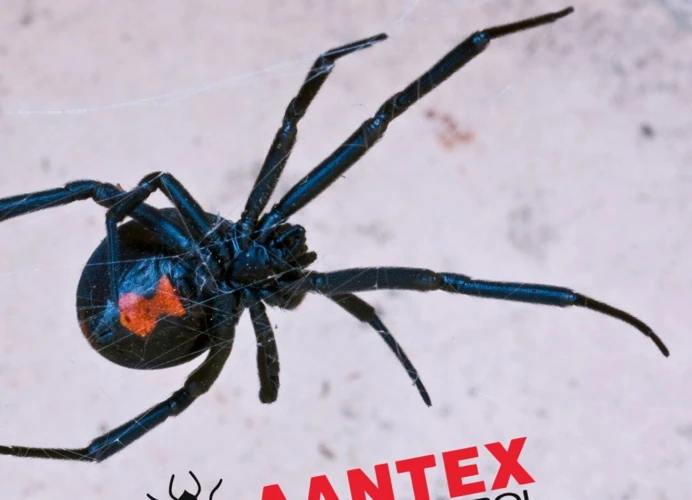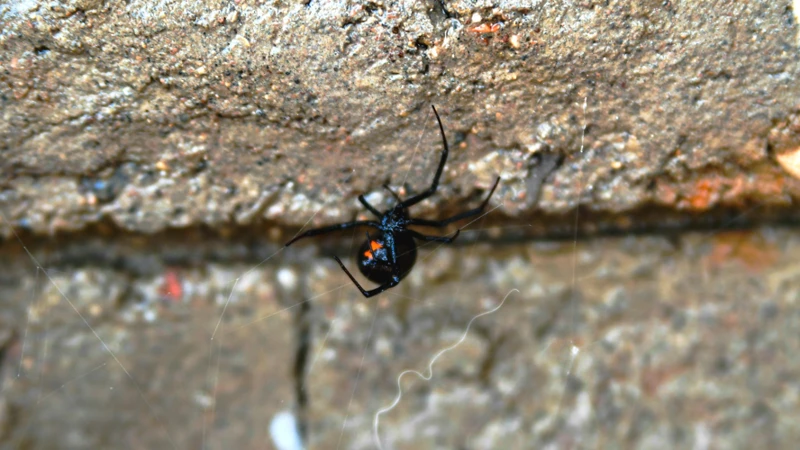Have you noticed an increase in the number of creepy crawlies lurking in your rural home lately? Of all the pests that could invade your personal space, black widow spiders are perhaps the most unwelcome. With venom potent enough to cause serious harm, it’s crucial to be able to identify and prevent these eight-legged creatures from making themselves comfortable in your living quarters. In this article, we’ll delve into the characteristics of black widow spiders, the risks they pose, and the most effective methods for keeping them at bay. Keep reading to learn everything you need to know about black widow spiders in rural areas.
Identifying Black Widow Spiders

The ability to identify black widow spiders is essential in understanding the risks they pose and how to prevent them from taking over your home. These venomous spiders are widespread, with black widow spiders in North America being the most well-known. However, they can also be found in other parts of the world, such as Asia, Europe, and South America. In this section, we will discuss the physical characteristics and distinctive markings that can help you identify black widow spiders.
Physical Characteristics of Black Widow Spiders
Black Widow Spiders are highly recognizable by their distinctive physical characteristics. Here are some of the physical features of black widows that you should be aware of:
- Glossy black color: Black Widow Spiders are known for their shiny black appearance, which can sometimes appear dark brown or even grayish in color depending on the environment they inhabit.
- Small size: Although Black Widow Spiders can grow up to one and a half inches in length, they are typically smaller, often measuring around half an inch to three-quarters of an inch in body length.
- A prominent abdomen: One of the most visible physical characteristics of the Black Widow Spider is its round, bulbous abdomen, which is often referred to as the spider’s “hourglass” shape.
- Eight legs: Like all spiders, Black Widows have eight legs, which are typically long, thin, and covered in fine hair.
- Fangs: Black Widows are also known for their large, black fangs, which are used to inject venom into their prey.
Knowing how to identify Black Widow Spiders by their physical characteristics can help you take necessary precautions to avoid them, which is especially important for individuals living in areas where Black Widow Spiders are common. If you want to learn more about the geographical distribution of Black Widow Spiders or their habitat range, you can follow the internal link to /black-widow-spiders-north-america/.
Distinctive Markings
Black Widow Spiders have distinctive markings that make them easily identifiable. These markings are not always present on every spider but are common in most Black Widow species. These spiders have jet-black bodies with a red hourglass-shaped mark on their abdomens. The hourglass shape is usually bright red, although some spiders may have a yellow or orange color.
In addition to the hourglass-shaped mark, some Black Widow species may also have other distinct markings on their bodies. The Southern Black Widow Spider, for example, has a series of bright red markings on its back that resemble a row of red dots. The Northern Black Widow Spider has a series of red spots on its back in a pattern that resembles a row of diamonds. These unique markings make it easier to distinguish between different Black Widow Spider species.
It is important to note that not all spiders with red markings on their bodies are Black Widows. Some other spider species, such as the Redback Spider in Australia, also have red markings on their bodies. However, these spiders are not as dangerous as Black Widows and are not found in rural areas in North America.
It is essential to be able to recognize the markings of a Black Widow Spider. These spiders are venomous and can pose a significant danger to humans and their pets. If you suspect that you have come across a Black Widow Spider, it is best to avoid touching it and contact a professional pest control service to handle the situation.
If you want to learn more about the distribution of these spiders in different regions, check out our articles on their presence in Europe, their urban habitats, and the impact of habitat destruction on their populations. Additionally, to understand the risks and fatalities associated with Black Widow Spider bites, read about their geographic distribution and suburban habitats, as well as their presence in South America and at different altitudes.
Risks of Black Widow Spiders in Rural Areas

The thought of black widow spiders lurking in rural areas can be a cause for concern and can instill fear in many people. These spiders are infamous for their venom and bites, which can cause serious harm to humans. It’s important to understand the risks associated with black widow spiders to take necessary precautions. While the black widow is commonly found in North America, its presence has spread globally with human activity. Let’s dive deeper into the risks of black widow spiders in rural areas.
Health Risks
Black Widow Spiders in rural areas are known for their danger to humans and animals, and it’s important to understand the health risks associated with encounters with these arachnids. Below is a table highlighting the potential health risks of Black Widow Spider bites.
| Health Risk | Symptoms |
|---|---|
| Systemic toxicity | Nausea, muscle pain, abdominal cramps, and spasms. |
| Severe allergic reactions | Difficulty breathing, swelling, and redness. |
| Neurological symptoms | Headaches, dizziness, and tremors. |
Black Widow Spider bites can have severe consequences for those who are bitten. In addition to the health risks listed above, the venom of the Black Widow Spider can also cause high blood pressure, rapid heart rate, and even lead to seizures. It’s important to note that while bites from Black Widow Spiders can be dangerous, they are quite uncommon.
It’s also important to understand that bites from other spider species are often mistaken for those from the Black Widow Spider. If you suspect that you have been bitten by a spider of any kind, seek medical attention immediately.
While the thought of encountering a Black Widow Spider may cause fear and anxiety, it’s important to stay informed and understand the potential risks associated with these creatures. By taking preventative measures, you can help reduce the likelihood of an encounter and stay safe.
Common Misconceptions
Many people have misconceptions about black widow spiders, which can lead to unnecessary fear and panic. Here are some common misconceptions about them:
- Only female black widows are dangerous. While it’s true that female black widows are the ones that have venomous bites, male black widows are not harmless. They may bite if threatened, although their venom is not as potent as the females’.
- Black widows are aggressive and will attack humans. Black widows are actually shy and avoid human contact as much as possible. They will only bite if they feel threatened, such as when their web or nest is disturbed.
- All black widow spiders have a red hourglass marking on their abdomen. While the red hourglass is a common marking for black widows, not all of them have it. Some have spots or no markings at all.
- Black widows are only found in the United States. While it’s true that black widows are common in the United States, they are also found in other parts of the world, such as Asia. In fact, the Asia black widow spider has a distribution that includes China, Japan, and Korea, among others.
It’s important to educate yourself about black widow spiders and dispel any myths or misconceptions you may have heard. By knowing the facts, you can better protect yourself and your family from these potentially dangerous spiders.
Internal Link: To learn more about suburban black widow spiders, click here.
Preventing Black Widow Spiders from Taking Over Your Home

As rural areas provide an ideal habitat for black widow spiders, they can easily take over your home if you don’t take adequate preventive measures. It’s important to understand the effective ways to keep these venomous pests away to ensure the safety of your family and pets. In this section, we will discuss some practical tips for preventing black widow spiders from entering and thriving in your home. By following these tips, you can minimize the risk of a black widow infestation in your house.
Exterior Prevention
One of the most effective ways to prevent black widow spiders from entering your home is by taking preventative measures on the exterior of your property. Here are some tips to consider:
- Seal Any Cracks and Gaps: Black widow spiders can enter through even the tiniest of openings. Inspect your home’s foundation, walls, and windows for any openings and seal them with caulk or weather stripping.
- Clear Away Clutter: Black widows love dark and cluttered areas, so it’s important to keep your yard free from debris, including piles of firewood, old furniture, and other items that could provide a hiding spot for these pests.
- Secure Trash Bins: If your outdoor trash bins are not sealed tight, they could attract black widow spiders to your property. Make sure to secure your trash bins with tight-fitting lids.
- Trim Back Vegetation: Thick vegetation can provide the perfect hiding place for black widows. Trim back any bushes, shrubs, or plants that are touching the exterior of your home.
- Consider a Professional Treatment: If you live in an area where black widows are prevalent, you may want to consider a professional treatment for your outdoor space. A pest control professional can apply a targeted treatment to your yard to help prevent spiders from entering and nesting around your home.
Taking these preventative measures can help minimize the risk of a black widow infestation in your home. By keeping your property well-maintained and free of clutter, you’ll be able to enjoy the outdoors without the fear of encountering these dangerous pests. If you’re curious about the distribution of black widow spiders in Asia, you can read more at /asia-black-widow-distribution/.
Interior Prevention
When it comes to preventing black widow spiders from infiltrating your home, it’s important to not only focus on the exterior of your property but also the interior. Here are some tips for preventing black widow spiders from becoming a problem inside your home:
| Tip | Description |
|---|---|
| Reduce clutter | Black widows often hide in cluttered areas such as closets, basements, and garages. By reducing clutter in these areas, you can eliminate potential hiding spots. |
| Seal gaps and cracks | Inspect your home for any gaps or cracks where black widows could enter. Common entry points include around windows and doors, pipes, and vents. Use caulk, weatherstripping, or other sealants to block these entry points. |
| Keep a clean home | Regularly clean your home, paying close attention to areas where black widows may hide such as behind furniture, in corners, and in cabinets. Sweep or vacuum floors, dust surfaces, and wipe down counters to keep your home free of spider webs and eggs. |
| Use spider traps | Spider traps can be placed in areas where black widows are likely to hide. These traps are designed to attract and capture spiders without the use of harmful pesticides. |
| Eliminate food sources | Black widows feed on other insects, so eliminating their food sources can help prevent them from taking up residence in your home. Keep food stored in airtight containers and take out the trash regularly. |
By following these tips, you can greatly reduce the risk of black widow spiders infesting your home. Remember to always take precautions when working in areas where spiders may be present and to contact a professional if you suspect a spider infestation that you cannot handle on your own.
Dealing With a Black Widow Infestation
As much as we try to prevent it, sometimes black widow spiders can still find their way into our homes and create an infestation. This can be a daunting situation, as black widows are known for their venomous bites and potentially deadly effects. But don’t panic just yet – there are steps you can take to effectively deal with a black widow infestation. Let’s explore some strategies for eradicating these dangerous pests from your home.
When to Call a Professional
Dealing with a black widow infestation can be a daunting task and sometimes it’s best to leave it to the professionals. Here are some instances when you should definitely call for help from a pest control company or an exterminator:
- Large Infestations: If you see several black widows crawling around in your home or yard, it’s best to call a professional as soon as possible. A large infestation can pose serious health risks and the longer you wait, the more difficult it will be to get rid of them.
- Identifying the Source: If you’ve tried various DIY treatments but are still seeing black widows, it’s possible that there’s an underlying cause that needs professional attention. A pest control expert can help you identify the source of the infestation and provide a long-term solution.
- Unfamiliar Species: If you’re unsure whether you’re dealing with black widows or a different species of spider, it’s best to leave it to the professionals. They have the necessary expertise to identify the spider and determine the best course of action.
- Medical Concerns: If someone in your household has been bitten by a black widow spider, seek medical attention immediately. In some cases, the venom can be life-threatening, especially in children and individuals with weakened immune systems.
Remember, black widows are dangerous spiders and should not be taken lightly. It’s better to be safe than sorry, so if you have any concern about a black widow infestation, don’t hesitate to call for professional help.
DIY Treatments
When dealing with a black widow spider infestation, there are a few DIY treatments that can be effective in eliminating these dangerous pests. Here are some suggestions:
- Diatomaceous Earth: This is a natural substance that is made up of the fossilized remains of tiny aquatic creatures. When sprinkled around your home, it can dehydrate and kill black widow spiders. Be sure to use food-grade diatomaceous earth, as other forms can be harmful to humans and pets.
- Sticky Traps: Place sticky traps in areas where black widows are likely to be found, such as corners, basements, and garages. These traps will capture the spiders and prevent them from spreading.
- Essential Oils: Black widow spiders dislike the smell of some essential oils, such as peppermint, eucalyptus, and lavender. Mixing a few drops of these oils with water and spraying it around your home can help deter the spiders from entering.
- Vacuuming: Using a vacuum with a long attachment, vacuum up any black widow spiders you see, as well as their webs and egg sacs. Be sure to dispose of the contents of the vacuum in a sealed plastic bag.
- Sealing Cracks: Black widow spiders can enter your home through small cracks and crevices. Seal any openings with caulk or weatherstripping to prevent them from getting in.
While these DIY treatments can be effective in eliminating black widow spiders, it’s important to note that they may not be sufficient for severe infestations. In these cases, it’s best to call in a professional pest control company to assess and treat the problem.
Conclusion
After learning about the risks and prevention methods for Black Widow Spiders in rural areas, it’s clear that these venomous spiders can pose a significant threat to both humans and pets. It’s important to be able to identify these spiders by their physical characteristics and distinct markings so that precautions can be taken to prevent them from entering your home.
Exterior and interior prevention measures can be taken to keep Black Widows away. These methods include sealing cracks and holes, using screens and weatherstripping, and keeping outdoor areas clean and clutter-free. When dealing with a Black Widow infestation, it’s always best to err on the side of caution and call a professional pest control service.
It’s important to remember that Black Widows are not aggressive spiders and will only bite when threatened or provoked. However, it’s still crucial to take their presence seriously and take steps to prevent them from entering your home and outdoor areas. By following the recommended prevention methods and staying informed on proper treatment, you can keep your family and pets safe from the dangers of Black Widow Spiders.
Frequently Asked Questions
What should I do if I find a black widow spider in my house?
If you find a black widow spider in your house, do not handle it. Contact a pest control professional for safe removal.
Is the black widow spider the only venomous spider in rural areas?
No, there are other venomous spiders found in rural areas such as the brown recluse spider. It is important to learn how to identify different species of spiders to know the appropriate steps to take in preventing and dealing with infestations.
Can I get rid of black widow spiders on my own?
DIY methods can help control black widow spider populations, but it is recommended to contact a pest control professional for effective and safe removal.
Do black widow spiders only live in rural areas?
Black widow spiders can be found in both rural and urban areas. However, rural areas where there are large portions of undisturbed land and less human activity may have a higher population of black widow spiders.
What are the health risks of a black widow spider bite?
Black widow spider bites can cause severe symptoms such as muscle cramps, nausea, and respiratory issues. In rare cases, the bite can be fatal.
What should I wear when dealing with a black widow infestation?
Wear protective clothing such as long-sleeved shirts, pants, gloves, and closed-toe shoes when dealing with a black widow infestation.
How can I prevent black widow spiders from entering my house?
Seal all gaps and cracks on the exterior of your home, keep vegetation trimmed, and store firewood away from the house to prevent black widow spiders from entering your home.
How can I tell if I have a black widow infestation?
If you spot multiple black widow spiders indoors or around your property, you may have an infestation. Look for spider webs in dark and undisturbed areas.
Do I need to worry about black widow spiders if I have pets?
Yes, black widow spider bites can affect pets as well. Keep your pets away from areas where you suspect the presence of black widow spiders.
What is the best way to dispose of a black widow spider?
It is recommended to contact a pest control professional for safe removal of a black widow spider.







